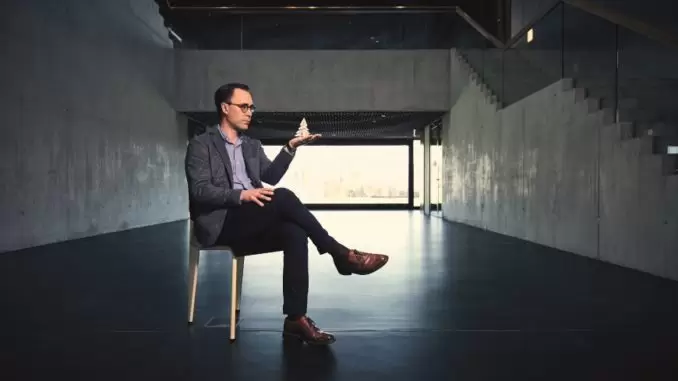
Views: 52
When Gustav Nyström sees a tree, he sees more than just a biological marvel. “A tree is a great example of how functionality, structure and beauty come together in nature and evolution,” says the new head of Empa’s Cellulose & Wood Materials lab. For him, the trunk, leaves and roots are also a source of novel materials, which enable a wealth of potential new applications. And the fact that forests cover roughly one third of Switzerland and provide a sustainable, readily available resource is what makes wood so fascinating for Nyström.
Courtesy EMPA by | ANDREA SIX : The new head of Empa’s Cellulose & Wood Materials lab, Gustav Nyström, has taken everyone by surprise by setting unconventional goals. However, paper batteries and nanocellulose sensors have one main objective: to help solve fundamental, socially relevant questions.
Rebuilding wood
In times of climate change, the researcher is convinced that we should rely on CO2-neutral raw materials. And thus he is in line with the current creative minds who design skyscrapers and even bikes made of wood. Nyström also wants to maximize the potential wood harbors as a raw material by equipping it with completely new properties. If wood becomes electrically conductive or magnetic, or if its structure is modified with the aid of microorganisms, for instance, innovative composite materials can be developed for novel applications.
Nyström is focusing on the pressing problems of our time, such as energy storage, and endeavors to find solutions based on new materials. These include batteries made of sustainable raw materials, which degrade on their own in the environment, but also drinks bottles made of wooden components – buzzword plastic waste. With this in mind, his team is developing wood-based polymers and cellulose particles in combination with proteins, which should one day replace problematic everyday objects such as plastic bottles or transparent packaging film, without polluting the oceans in the form of garbage islands. For Nyström, lemonade in cellulose bottles and foils made of environmentally friendly polymers is not just wishful thinking, but an absolute necessity
“As a researcher, I want to understand the relationships between these kinds of new high-performance materials. But above all I want my work to contribute to a better future,” says Nyström. One of his new projects at Empa is a battery … made of paper. “Certain structures in wood can be used to store energy,” he explains. The Swede’s PhD thesis in Uppsala had already focused on energy-saving nanofibrils made of natural cellulose.
Drinking bottles made from wood

Gustav Nyström: Following his physics degree at KTH Royal Institute of Technology in Stockholm and at Darmstadt University of Applied Sciences, the Swedish-born scientist completed his doctorate in organic electronics and paper-based energy storage at the University of Uppsala in Sweden in 2012. Before joining Empa, Nyström was a lecturer and senior scientist at the Department of Health Sciences and Technology at ETH Zurich. The 38-year-old has been running Empa’s Cellulose & Wood Materials lab since March 2018.
He is convinced that the diversity of his team is an essential ingredient in his recipe for success. For instance, he sets great store by having experts from as many different disciplines as possible in his team. It might sound unusual that, as a physicist, he is proving successful in his present research field. Surrounded by chemists, wood scientists and biophysicists, however, the thinking is always flexible and, above all, critical. And only in this melting pot of disciplines can creativity thrive.
The same goes for the researchers’ backgrounds. “I appreciate the international nature of our team,” says Nyström. “The researchers bring interesting experiences to the table, and we benefit from the fact that different topics are taught in a different style at foreign universities.” Nyström himself studied in Sweden and Germany. But this wasn’t his childhood dream: “I grew up in the country. When I was a boy, I wanted to become a fisherman. I had no concept of what a ‘professor’ was.” Today, he describes himself as creative, focused and, above all, well organized. “I have three young children. I have to find practical and consistent solutions to strike a good balance between the time I spend on my career and with my family and to be able to cope with my hectic everyday life.”
Moreover, he believes the success of a team is also based on the openness, with which it communicates. “Creativity can only thrive if thoughts and information are shared and challenged.” If everyone is reluctant to risk sharing his or her ideas, no new projects will ever come about.
At eye level with Canada
Ultimately, new composite materials should be created in Nyström’s lab based on wood and cellulose, the development of which is rooted in all areas of the research field. Proteins from wood pathogens such as fungi, nanocellulose made of algae or fireproof wood – Nyström sees a huge potential precisely in the interplay between different research approaches. “Excellent research can mean finding a piece in the puzzle for a highly complex problem,” he says. “However, I find it more elegant to find simpler solutions that could potentially help more people. Instead of solving the hardest puzzle in the world, sometimes it might be about inventing an easier puzzle.” And this is precisely why Nyström appreciates combining basic research with industrial applications at Empa. “Internationally, Switzerland is competing with heavyweights like Canada or the US in cellulose and wood research. And we’re right up there with them, too.”
Leave a Reply